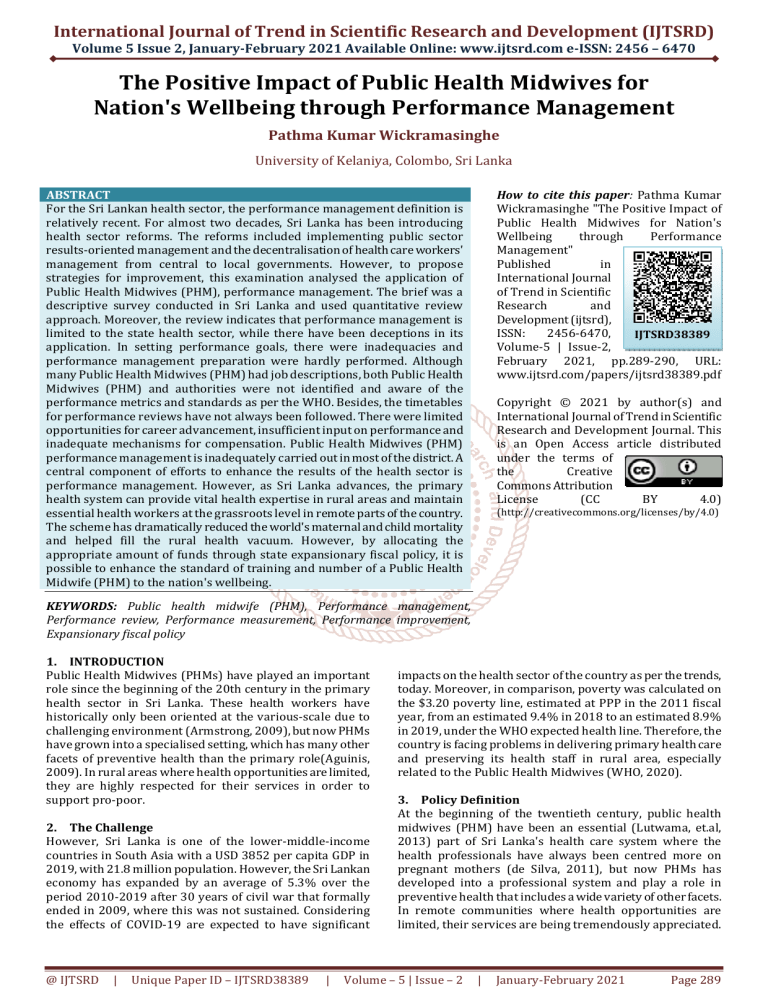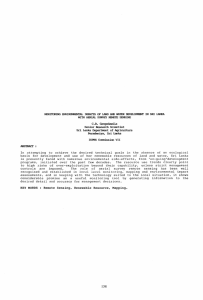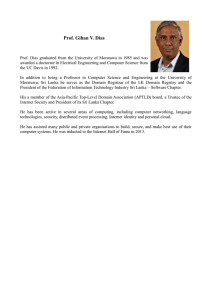
International Journal of Trend in Scientific Research and Development (IJTSRD)
Volume 5 Issue 2, January-February 2021 Available Online: www.ijtsrd.com e-ISSN: 2456 – 6470
The Positive Impact of Public Health Midwives for
Nation's Wellbeing through Performance Management
Pathma Kumar Wickramasinghe
University of Kelaniya, Colombo, Sri Lanka
How to cite this paper: Pathma Kumar
Wickramasinghe "The Positive Impact of
Public Health Midwives for Nation's
Wellbeing
through
Performance
Management"
Published
in
International Journal
of Trend in Scientific
Research
and
Development (ijtsrd),
ISSN:
2456-6470,
IJTSRD38389
Volume-5 | Issue-2,
February 2021, pp.289-290, URL:
www.ijtsrd.com/papers/ijtsrd38389.pdf
ABSTRACT
For the Sri Lankan health sector, the performance management definition is
relatively recent. For almost two decades, Sri Lanka has been introducing
health sector reforms. The reforms included implementing public sector
results-oriented management and the decentralisation of health care workers'
management from central to local governments. However, to propose
strategies for improvement, this examination analysed the application of
Public Health Midwives (PHM), performance management. The brief was a
descriptive survey conducted in Sri Lanka and used quantitative review
approach. Moreover, the review indicates that performance management is
limited to the state health sector, while there have been deceptions in its
application. In setting performance goals, there were inadequacies and
performance management preparation were hardly performed. Although
many Public Health Midwives (PHM) had job descriptions, both Public Health
Midwives (PHM) and authorities were not identified and aware of the
performance metrics and standards as per the WHO. Besides, the timetables
for performance reviews have not always been followed. There were limited
opportunities for career advancement, insufficient input on performance and
inadequate mechanisms for compensation. Public Health Midwives (PHM)
performance management is inadequately carried out in most of the district. A
central component of efforts to enhance the results of the health sector is
performance management. However, as Sri Lanka advances, the primary
health system can provide vital health expertise in rural areas and maintain
essential health workers at the grassroots level in remote parts of the country.
The scheme has dramatically reduced the world's maternal and child mortality
and helped fill the rural health vacuum. However, by allocating the
appropriate amount of funds through state expansionary fiscal policy, it is
possible to enhance the standard of training and number of a Public Health
Midwife (PHM) to the nation's wellbeing.
Copyright © 2021 by author(s) and
International Journal of Trend in Scientific
Research and Development Journal. This
is an Open Access article distributed
under the terms of
the
Creative
Commons Attribution
License
(CC
BY
4.0)
(http://creativecommons.org/licenses/by/4.0)
KEYWORDS: Public health midwife (PHM), Performance management,
Performance review, Performance measurement, Performance improvement,
Expansionary fiscal policy
1. INTRODUCTION
Public Health Midwives (PHMs) have played an important
role since the beginning of the 20th century in the primary
health sector in Sri Lanka. These health workers have
historically only been oriented at the various-scale due to
challenging environment (Armstrong, 2009), but now PHMs
have grown into a specialised setting, which has many other
facets of preventive health than the primary role(Aguinis,
2009). In rural areas where health opportunities are limited,
they are highly respected for their services in order to
support pro-poor.
2. The Challenge
However, Sri Lanka is one of the lower-middle-income
countries in South Asia with a USD 3852 per capita GDP in
2019, with 21.8 million population. However, the Sri Lankan
economy has expanded by an average of 5.3% over the
period 2010-2019 after 30 years of civil war that formally
ended in 2009, where this was not sustained. Considering
the effects of COVID-19 are expected to have significant
@ IJTSRD
|
Unique Paper ID – IJTSRD38389
|
impacts on the health sector of the country as per the trends,
today. Moreover, in comparison, poverty was calculated on
the $3.20 poverty line, estimated at PPP in the 2011 fiscal
year, from an estimated 9.4% in 2018 to an estimated 8.9%
in 2019, under the WHO expected health line. Therefore, the
country is facing problems in delivering primary health care
and preserving its health staff in rural area, especially
related to the Public Health Midwives (WHO, 2020).
3. Policy Definition
At the beginning of the twentieth century, public health
midwives (PHM) have been an essential (Lutwama, et.al,
2013) part of Sri Lanka's health care system where the
health professionals have always been centred more on
pregnant mothers (de Silva, 2011), but now PHMs has
developed into a professional system and play a role in
preventive health that includes a wide variety of other facets.
In remote communities where health opportunities are
limited, their services are being tremendously appreciated.
Volume – 5 | Issue – 2
|
January-February 2021
Page 289
International Journal of Trend in Scientific Research and Development (IJTSRD) @ www.ijtsrd.com eISSN: 2456-6470
The Sri Lankan government has initiated various strategies
to enable health workers to work in rural areas. PHM
recruiting in isolated rural areas is preferred, and higher
PHMs in areas with low health metrics are distributed. More
than 90 % of PHM trainees are posted in rural areas after
their training course (de Silva, 2015), which has been
completed. There is a minimum regional training centre in
each district, where PHMs are qualified to provide quality
health care to village mothers and children to ensure that
they have sufficient professional skills (World Bank, 2020).
They still once have access to continuous job openings, even
though they are in significantly distant areas. PHM trainees
shall complete the 5-year bond term after graduating and
must be ready to work anywhere in their training province.
However, this makes it easier to fill healthcare positions in,
especially under-resourced communities. There are also
financial resources to enable PHMs to continue with various
advantages in remote areas, such as grant opportunities,
pension systems, mobile communications, and own
transport(MOH, 2020).
4. The Results
Government projects have indicated fewer capability and
considerable shortages in rural regions, and that trained
public health midwives (PHM) provide limited care in
impoverished and remote areas. The effect on health
indicators can be seen in the effective recruiting, training
and posting systems in the rural sector, which is significant.
In recent decades, in 2003, the mother mortality rate (MMR)
fell from 265 in 1935 to 5.3 per 10,000, public health
midwives (PHM) support births and in 2003 from 263 in
1935 to 11.2 per 1,000 live public health midwives (PHM)
births. Since the beginning of the 20th century in Sri Lanka,
the Public Health Midwife (PHM) offered maternally and
child health care at the community level. The PHM is the
frontline health provider in the neighbourhood who
provides childbirth to children and is the conduit between
the rural and state health institutions. However, the PHMs
carry a 40-hour WHO / UNICEF breastfeeding therapy
training curriculum that addresses all the required subjects
and provides practical professional training. In a longitudinal
survey in Sri Lanka, there was a high rise in the number of
mothers breastfeeding their children for six months and the
median period for exclusive breastfeeding–all of them at
comparatively low prices. Today's Sri Lanka has one of the
world's top breastfeeding outcomes, with 99% of infants
breastfed and 82% breastfed exclusively for the first six
@ IJTSRD
|
Unique Paper ID – IJTSRD38389
|
months, which is a wonder of Public Health Midwife (PHM),
service.
5. Recommendation
However, the primary health system in Sri Lanka's progress
is that it can provide critical health expertise in rural areas
and maintain essential healthcare staff at a grassroots level
in remote areas of the country. The scheme has helped
significantly decrease maternal and infant mortality in the
world and helped fill the void in rural health. However, it is
required to enhance the quality of the training and number
of Public Health Midwife (PHM) by allocating the required
amount of funds through state expansionary fiscal policy.
References
[1] (MOH, 2020).
http://www.health.gov.lk/moh_final/english/others.
php?pid=155[2]
Aguinis, H. (2009). Performance management. Upper
Saddle River, NJ: Pearson/Prentice Hall.
[3]
Armstrong, M. (2009). Armstrong's handbook of
performance management: An evidence-based guide
to delivering high performance. Kogan Page
Publishers.
[4]
de Silva, A. P. (2015). The contribution of Public
Health Midwives to better health in rural
communities in Sri Lanka, sl: WHO.
[5]
Lutwama, G.W., Roos, J.H. &Dolamo, B.L.(2013).
Assessing the implementation of performance
management of health care workers in Uganda. BMC
Health Serv Res 13, 355 (2013).
https://doi.org/10.1186/1472-6963-13-355.
[6]
Pubudu de Silva, A. (2011). The contribution of public
health midwives to better health in rural communities
in Sri Lanka. In Case stories—Second Global Forum on
Human Resources for Health, Bangkok, Thailand.
[7]
WHO, (2020), work force-
[8]
https://www.who.int/workforcealliance/forum
health workforce crisis and to build networks?
World Bank, (2020).
Worldbank.org/en/country/srilanka/overviewRecent developments-health.
Volume – 5 | Issue – 2
|
January-February 2021
Page 290






